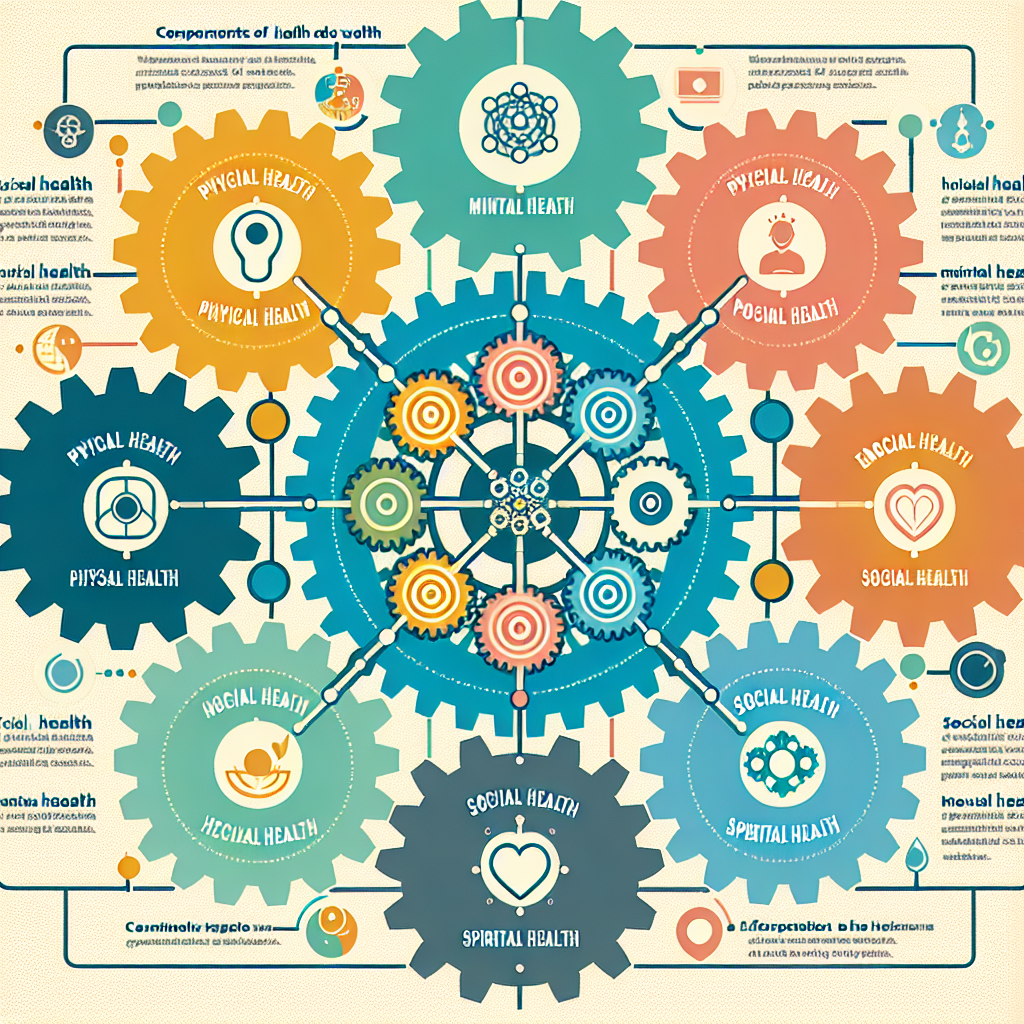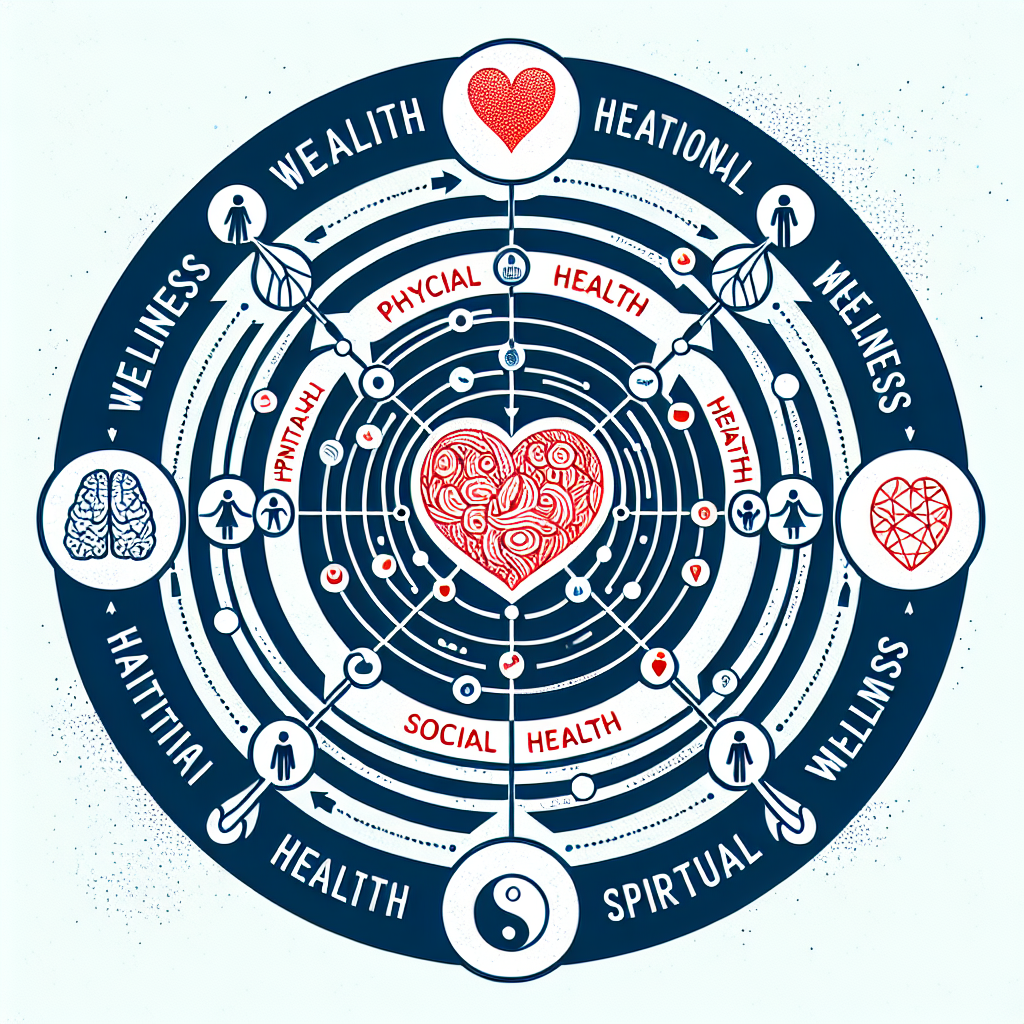In the modern world, the pursuit of wellness has become a significant focus for individuals and communities alike. Wellness is a holistic concept that encompasses various aspects of health, including physical, mental, emotional, and social well-being. This article will explores and summarize how the components of health are related to wellness. In doing so, we provide a comprehensive understanding of how achieving a balance in these components can lead to a fulfilling and healthy life.
Defining the Components of Health
To understand how the components of health are related to wellness and to summarize how the components of health are related to wellness, it is essential to define these components:
- Physical Health:
This entails preserving physical health with consistent exercise, a well-balanced diet, enough sleep, and abstaining from unhealthy habits. The cornerstone upon which other aspects of health are constructed is physical health.
- Mental Health:
Mental health is related to cognitive abilities and involves upholding mental acuity, lifelong learning, and psychological well-being management. It entails making choices, managing stress, and encouraging creativity.
- Emotional Health:
The goal of emotional wellness is to recognize and control feelings. It entails being conscious of one’s emotions, expressing them in a way that is suitable, and keeping an optimistic attitude on life.
- Social Health:
Making a positive impact on the community and developing meaningful relationships are key to social health. It includes the capacity for empathy, effective communication, and the creation and maintenance of positive relationships.
How Each Component Contributes to Overall Wellness
The components of health are interrelated and collectively contribute to overall wellness. When one aspect of health is neglected, it can adversely affect others. To understand how the components of health are related to wellness, let’s explore each component in detail:
Physical Health
The easiest to measure and most obvious is physical health. Exercise on a regular basis, a healthy diet, and enough sleep are essential. Prioritizing physical health results in better mood, more energy, and a lower chance of developing chronic illnesses. For example, a community in Okinawa, Japan, is renowned for its long life expectancy and low incidence of chronic illnesses because of their active lifestyle, robust social networks, and traditional cuisine.
Mental Health
Sustaining emotional stability and cognitive abilities depends on mental wellness. Continuous learning and meditation are two practices that have been shown to dramatically improve mental health. For instance, a person’s mental and emotional well-being was enhanced when they successfully managed stress and anxiety through the regular practice of yoga and meditation.
Emotional Health
Emotional intelligence and self-control are essential for general wellbeing. Relationships, self-worth, and general happiness are all impacted by emotional wellness. Employees were able to manage their emotional health with the support of a corporate wellness program that included stress management courses, which decreased absenteeism and raised job satisfaction.
Social Health
A fulfilling life requires establishing and preserving important relationships. Social connections boost mental health, ease stress, and offer support. Community cooking and gardening classes were developed as part of a local program to encourage healthy food and physical activity. This improved participant health and sense of community.

The Importance of Lifestyle Choices and Behaviors in Maintaining Wellness
Lifestyle choices and behaviors play a critical role in maintaining wellness. In order to summarize how the components of health are related to wellness Positive habits such as regular exercise, healthy eating, and stress management contribute to long-term health benefits. Dr. Dean Ornish, a clinical professor of medicine, emphasizes, “It’s not all or nothing, but every little bit, every day, makes a difference.” This highlights the cumulative effect of small, consistent actions on overall wellness.
The Role of Healthcare Professionals in Promoting Wellness
Healthcare providers have a big part to play in promoting wellness by teaching patients and providing preventative care. Healthcare professionals can assist people in preserving their health and preventing chronic diseases by emphasizing prevention over treatment. Cardiology specialist Dr. Mimi Guarneri says, “We need to change the conversation from illness to wellness. The path to wellness is always the same, regardless of the illness: nutrition, exercise, stress reduction, rest, and social support.”
Challenges to Achieving Wellness in Today’s Society and Potential Solutions
In today’s world, a number of issues, including hectic lives, environmental stressors, and restricted access to healthcare, can make achieving wellness difficult. It is crucial to establish surroundings that are supportive and promote healthy behaviors in order to overcome these obstacles. According to Blue Zones project founder Dan Buettner, “the biggest mistakes people make are not taking a big enough first step, and not living in an environment that nudges them into the right direction.” Buettner emphasizes the significance of community and environment in improving health.
The Link Between Personal Fulfillment and Wellness
Well-being and personal fulfillment are intimately related. People are more likely to act in ways that advance their health and well-being when they feel fulfilled. According to integrative medicine pioneer Deepak Chopra, “wellness is the complete integration of body, mind, and spirit – the realization that everything we do, think, feel, and believe has an effect on our state of well-being.” Exchange of words is taken place on health and wellness topic at different media forums.
Strategies for Individuals to Improve Their Health Across All Components for Enhanced Wellness
To enhance wellness, individuals can adopt various strategies to improve their health across all components:
- Physical Health:
Engage in regular physical activity, follow a balanced diet, and ensure adequate rest.
- Mental Health:
Practice mindfulness, engage in continuous learning, and seek professional help when needed.
- Emotional Health:
Develop emotional intelligence, practice gratitude, and build resilience.
- Social Health:
Cultivate meaningful relationships, participate in community activities, and practice effective communication.

Conclusion
Understanding how the components of health are related to wellness is crucial for achieving and maintaining overall well-being. By focusing on physical, mental, emotional, and social health, individuals can lead fulfilling lives and contribute positively to their communities. Remember, as Dr. Maya Angelou beautifully puts it, “My mission in life is not merely to survive, but to thrive; and to do so with some passion, some compassion, some humour, and some style.”
What are the main components of health?
How does physical health contribute to overall wellness?
What is the importance of mental health in wellness?
How does emotional health affect one’s life?
Why is social health important for wellness?
How do lifestyle choices impact wellness?
What role do healthcare professionals play in promoting wellness?
What are some challenges to achieving wellness in today’s society?
How are personal fulfillment and wellness connected?
What strategies can individuals use to improve their overall wellness?
Engage in regular physical activity and maintain a balanced diet.
Practice mindfulness and continuous learning.
Develop emotional intelligence and resilience.
Cultivate meaningful relationships and participate in community activities.

